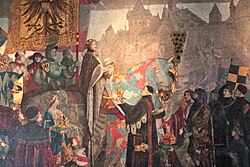Strasbourg
Strasbourg is a city in eastern France, the prefecture of Grand Est. Today, about 275,000 people live there (with around 780,000 in the metropolitan area). It lies on the left bank of the Rhine, opposite the German city of Kehl.
|
Strasbourg | ||
| From top left: Central Station; Strasbourg Cathedral and the Old Town; Ponts Couverts; Palais Rohan; Petite France; Palais du Rhin; Hôtel Brion; Hemicycle of the European Parliament; Strasbourg skyline in 2014 | ||
|

| |
| Administration | ||
|---|---|---|
| Country | France | |
| Region | Alsace | |
| Department | Bas-Rhin | |
| Arrondissement | Strasbourg | |
| Canton | 6 cantons | |
| Intercommunality | Strasbourg Eurométropole | |
| Mayor | Roland Ries (PS) (2014–2020) | |
| Statistics | ||
| Elevation | 132–151 m (433–495 ft) | |
| Land area1 | 78.26 km2 (30.22 sq mi) | |
| Population2 | 276,170 (1 January 2014[1]) | |
| - Ranking | 7th in France | |
| - Density | 3,529/km2 (9,140/sq mi) | |
| Urban area | 224 km2 (86 sq mi) (2013[2]) | |
| - Population | 456,759[3] (2013[2]) | |
| Metro area | 1,351.5 km2 (521.8 sq mi) (2013[2]) | |
| - Population | 773,347[4] (2013[2]) | |
| Dialling code | 0388, 0390, 0368 | |
| Website | www | |
| 1 French Land Register data, which excludes lakes, ponds, glaciers > 1 km² (0.386 sq mi or 247 acres) and river estuaries. | ||
| 2 Population without double counting: residents of multiple communes (e.g., students and military personnel) only counted once. | ||
Strasbourg is the seat Council of Europe, of the European Court of Human Rights and of the European Parliament. A lot of people also consider Strasbourg to be the capital of the European Union.
History
Its old town, la Grande Île ("Grand Island") has been classified as a World Heritage Site by UNESCO.
The city was founded in 12 BC by Drusus, the brother of Tiberius. Its Celtic name was Argentorate (which the Romans called Argentoratum). People think this name is linked to the river Ill (that flows into the Rhine near Strasbourg).
At that time, it was on the Limes, a fortification the Romans built across Europe (to keep out the Germanic tribes). There was a fortification (named castella drusi, drusus fort) at that spot. Soldiers need to live from something, so a local civilian settlement developed there. Later, the Limes was pushed farther east.
Climate
Strasbourg has an oceanic climate (Cfb in the Köppen climate classification).
Education
- École nationale supérieure d'informatique pour l'industrie et l'entreprise
- École pour l'informatique et les nouvelles technologies
- École pour l'informatique et les techniques avancées
- EM Strasbourg Business School
- Institut supérieur européen de gestion group
- ISG Programme Business & Management
- Web@cademie
Strasbourg Media
Sigismund, Holy Roman Emperor visiting Strasbourg in 1414, detail of a painting by Léo Schnug
Detailed OSM map of Strasbourg.
Panorama from the Barrage Vauban with the medieval bridge Ponts Couverts in the foreground (the fourth tower is hidden by trees at the left) and the cathedral in the distance on the right
The baroque organ of the Église Saint-Thomas
References
- ↑ "Populations légales 2014 des communes du département" (PDF). insee.fr. Retrieved 6 February 2017.
- ↑ 2.0 2.1 2.2 2.3 Only the part of the urban area on French territory.
- ↑ "AUnité urbaine de Strasbourg (partie française) (67701)". insee.fr. Retrieved 25 July 2016.
- ↑ "Aire urbaine de Strasbourg (partie française) (009)". insee.fr. Retrieved 25 July 2016.
Template:Prefectures of regions of France
![]()



















